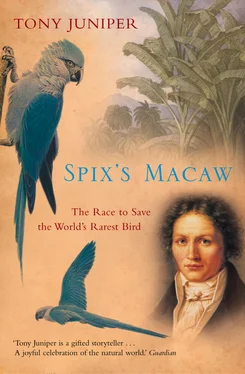Spix and Martius recorded their travels in three substantial volumes published in 1823, 1828 and 1831 in which they dedicated their great scientific achievements to their royal patron. ‘Attachment to Your Majesty and to the sciences was the Guardian Genius that guided us amidst the danger and fatigues of so extensive a journey, through a part of the world so imperfectly known, and brought us back in safety, from that remote hemisphere to our native land,’ they wrote. But only the first volume was a joint venture. Martius completed volumes two and three alone following the death of Spix in 1826. He was forty-six and had never really recovered from extremely poor health that resulted from the privations and sickness he experienced in Brazil. Martius went on to write a classic work on palms that he completed in 1850. He died in 1868.
Not only was the account of what they saw of great importance; their collection made a substantial contribution to the Natural History Museum of Munich. They brought back specimens from 85 species of mammals, 350 species of birds, 116 species of fish, 2,700 insects and 6,500 botanical specimens. They also managed to bring live animals back, including some parrots and monkeys. Many of their specimens were from species of animals and plants new to science.
Among the treasures brought home to Bavaria was the blue parrot shot by Spix near to Juàzeiro in the north of Bahia, not far from the river São Francisco. Since it was blue with a long tail, it seems that Spix believed he had taken a Hyacinth Macaw.
It was customary by this time for all species to be assigned a two-part name, mainly in the then international scientific language of Latin – but also Greek – following the classification system proposed during the eighteenth century by the Swedish naturalist Carl von Linné, better known as Linnaeus. The idea was to avoid the confusion often created by the use of several different colloquial names by adopting a common international system. The first part of the name denoted the genus, that is the group of closely related creatures or plants to which the specimen belonged. The second half of the title was to identify the particular species.
Whether he knew about Latham’s name for the blue parrot or simply used the name in ignorance (this occurred quite commonly in the early years of natural history classification), Spix confusingly called the little blue caatinga macaw Arara hyacinthinus in his volume called Avium Brasiliensium Species Novae published in 1824–5. He also had specimens of the larger, and similarly blue, Hyacinth Macaws that he proposed be renamed Anodorhyncho Maximiliani . ‘ Anodorhyncho ’ was a new name proposed by Spix to denote the genus of large blue macaws to which it belonged, and ‘ Maximiliani ’ was in honour of the King who had sponsored his explorations in South America.
The confusion that Spix evidently experienced in naming his blue parrots was quite understandable. Unlike modern naturalists, Spix was not able to rely on a glossy field book that succinctly set out with accurate colour pictures, maps and clear descriptions what birds he might encounter on his travels through the interior of Brazil. Even now, at the start of the twenty-first century, there is still no handy field and identification guide for Brazilian birds, although Helmut Sick’s 1993 Birds in Brazil provides a comprehensive overview of birds occurring in the country. It is worth noting that many dozens of guides are available for European birds, a portion of the globe with far fewer endangered species.
With no manual to rely on, it was not a straightforward business for Spix to recognise new species, let alone ones that had already been collected by other museums or expeditions. For a start, any naturalist seeking to catalogue a vast and diverse country like Brazil, even for a relatively obvious and distinctive group of animals like birds (even large blue parrots), would need a basic understanding of what had already been collected and what typical geographical variations might be expected over different species’ sometimes vast ranges. Such knowledge in early nineteenth-century Bavaria was, as elsewhere, extremely scarce.
It was not until 1832, six years after Spix’s death, that the magnitude of his error became apparent. The blue parrot he had collected in the caatinga, and so carefully transported all the way back to Munich, was utterly unique, unlike anything else ever catalogued: Spix had found a new species. It later emerged that not only was it a species new to science, it was a representative of a whole ‘new’ genus.
Spix’s mistake was noticed first by another Bavarian naturalist, his assistant Johann Wagler. Wagler, a Professor of Zoology at the University of Munich, realised that the bird collected by Spix was smaller than the birds previously described as Hyacinth Macaws and was a different colour too. It had a greyish head, black bare skin on its face, instead of the yellow patches seen in the Hyacinth, and it had a smaller and more delicate bill than the bigger Hyacinth Macaw and its relatives.
In his Monograph of Parrots published in 1832, Wagler paid tribute to the bird’s collector in the naming of a ‘new’ species after him; Sittace Spixii , he called it – a name basically meaning ‘Spix’s Parrot’. Wagler, like Spix, completed his bird book just in time. That same year, Wagler was involved in a shooting accident. He peppered his arm with small shot while out collecting birds. He contracted blood poisoning, amputation was fatally delayed and he died in the summer, aged thirty-two.
Following Wagler’s realisation that a species new to science had been found, the French naturalist Prince Charles Bonaparte proposed in the 1850s that it be placed in a new genus called Cyanopsittaca . Bonaparte, the son of Napoleon Bonaparte’s brother Lucien, was a passionate ornithologist who had a special interest in parrots. Since this bird was unlike the other blue macaws in several important respects, Bonaparte believed that a whole new genus of parrots was warranted. He took the Greek word for blue, Kyanos , and the Latin for parrot, Psittacus , to denote a new genus literally meaning ‘blue parrot’.
In the 1860s in a monograph of parrots compiled by the German ornithologist Otto Finsch there is an everyday German name that translated means ‘Spix’s Blue Macaw’. Finsch wrote that the small blue macaw was easy to distinguish from the Hyacinth Macaw because of its smaller size and more bare skin on its face and around its eyes. He concluded that it was ‘An exceedingly rare species and found in few museums. Discovered by Spix on the river São Francisco at Juàzeiro’. Significantly, he wrote that, ‘Other travellers do not mention it at all.’
Three decades later, the Italian zoologist Count Tommaso Salvadori compiled the Catalogue of the Parrots in the Collection of the British Museum . Salvadori completed his two-year task in 1891. He retained Spix’s bird in a genus called Cyanopsittacus . The fact that no other birds quite like it had been discovered meant that it remained in the genus on its own, thereby signalling that it was quite unique with characteristics seen in no other bird.
The second half of its scientific name was spixii . From now on, the bird collected in 1819 by the river São Francisco would be known in its scientific Latin form as Cyanopsittacus – or more commonly today Cyanopsitta spixii , and in English as Spix’s Macaw.
The fact that the species was now officially recorded was, however, to prove a mixed blessing. It intrigued not only scientists, but also conservationists and collectors, the former seeking to save the species, the latter to own and possess the most sought-after of all birds. But the blue caatinga parrots were to prove an elusive quarry for all concerned.
Читать дальше












